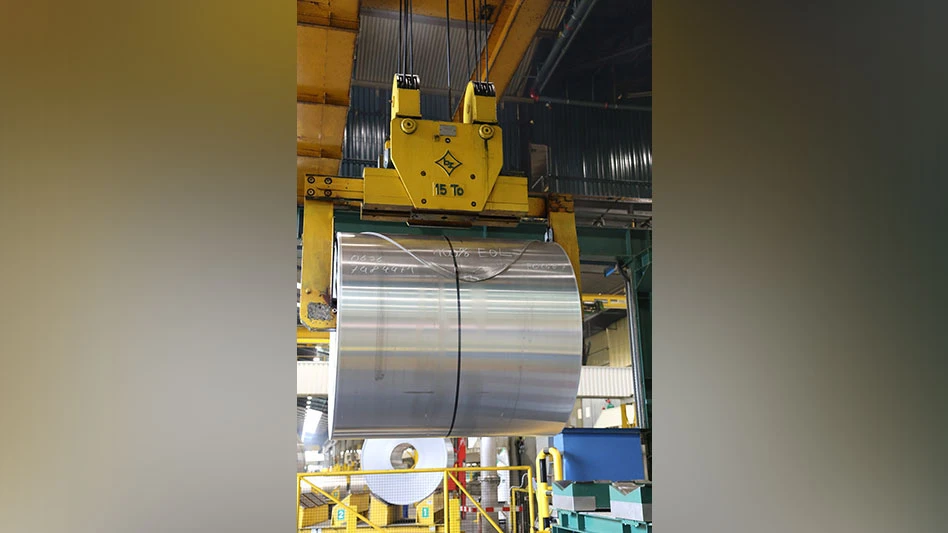Eastern Europe could be a helpful source of supply for a red-hot scrap market, but restrictive export strategies have in effect closed its docks to exports.
During the past 12 months, strong demand has created a surging market for a host of scrap metal grades. As the U.S. scrap industry struggles to process enough to sate the demand from a voracious global metals industry, one of the sources that could help keep supply and demand in balance has been pulling back.
Both the Ukraine and, to a lesser degree Russia, have implemented policies that are aimed toward reducing the amount of ferrous and nonferrous scrap metals from leaving their respective countries.
| Growth Spurt to Fizzle? |
|
Current figures for industrial ouput in the Ukraine are impressive, but looming mandates that will arrive with an expanded European Union (EU) could bring an end to the current growth spurt. According to a report in the Moscow Times, the Ukraine’s industrial output is on pace to grow more than 15 percent in 2003, well above forecasts made by the government. "We have planned for 6 percent industrial production growth in 2003, but in fact we have a rise of 15.7 percent in the [first] 10 months of the year," Ukraine deputy prime minister Vitaly Haiduk told the newspaper. Haiduk expressed a combination of surprise and concern, noting that while the growth is good for employment, the government is dismayed it cannot answer why output has escalated 2.5 times higher than forecast. The country’s economists have suggested favorable world market conditions for exports such as steel and chemicals, according to the Moscow Times. The good times could be deflated starting in May 2004, when some of the Ukraine’s favored trading partners join the EU, according to an Interfax Information Services report. At that time, trading partners such as Estonia, Lithuania, Poland, Hungary and the Czech Republic will have import restrictions for products coming from non-EU members such as the Ukraine. A Ukrainian first deputy foreign minister told Interfax that the incoming EU members will restrict their current 800,000 tons per year of metals imported from the Ukraine to 200,000 tons. |
While both countries are taking slightly different tacks to prevent what they consider to be too much scrap from leaving the country, both policies have run into a significant amount of opposition by the European Union, which is seeking freer trade across borders.
Russia and the Ukraine have enacted these policies to ensure that steel companies in these two countries have enough raw material to compete globally. But soaring prices would make it possible for scrap dealers to profitably ship material outside these countries.
CRIME STOPPERS. In the case of Russia, the government has imposed a quota on the amount of scrap that can leave the country. The reason behind this move was to ensure there was enough raw material to meet domestic raw material demand.
In the case of the Ukraine, a steep 30-Euros-per-metric-ton tariff on scrap metal has been imposed on scrap leaving the country. This ploy was done to make the material that much more expensive, again to guarantee a steady supply of raw material to meet domestic demands.
According to one source, however, another reason to attempt to reduce the outflow of scrap is to prevent or reduce the theft of metal from non-obsolete sources, such as vacant but commercially viable buildings.
While the reduction in scrap flow from the Ukraine has had an impact on the world market, steelmakers in Turkey most immediately felt the impact. With the flow of ferrous scrap from Black Sea ports cut off, Turkish buyers were left without one of their largest sources of raw material.
While the situation with the Ukraine has created some concerns, recent discussions between representatives from Turkey and Viktor Yanukovych, Ukraine’s prime minister, have sought ways to alleviate many of these problems.
One key issue is that Turkish manufacturers relied heavily on scrap metal from the Ukraine. However, according to various sources, large-scale scrap metal exports from the Ukraine to Turkey caused shortages of the raw material at Ukrainian mills and foundries.
Exacerbating the situation, some Turkish buyers ended up re-selling the scrap metal to other sources at sharply higher prices. This was one of the key reasons the Ukrainian government imposed a tariff of 30 Euros per metric ton.
According to various reports, the 30 Euros-per-metric ton duty resulted in a drop of exports, from 1.858 million metric tons the first half of 2002 to slightly less than 500,000 metric tons during the first half of last year.
During the recently concluded BIR meeting, Vadim Gurzhos, chairman of the Ukraine’s Metal Scrap Association, noted that ferrous scrap collection in his country was down about 1 million metric tons during the first eight months of 2003 compared to the same time the previous year.
During the same meeting, a spokeswoman from the Far Eastern Recycling Association, based in Vladivostok, Russia, noted that the scrap export duty had resulted in an "over saturation" of the domestic market, providing temporary support to the domestic steel industry, while gravely damaging the Russian scrap metal industry.
While the former Soviet countries are posing a fair amount of difficulties for many steelmakers in Turkey and elsewhere who have relied on this supply of material, the supply could best be used to help satisfy the growing Chinese market.
According to Charles Bradford, president of Bradford Research, a New York City-based consulting firm for the steel industry, the growth in Chinese steel production has been nothing short of staggering. Through the first nine months of last year, steel production in China grew by 21.6 percent. Further, Bradford notes, China accounted for more than one half of the world’s growth in steelmaking during the first nine months of last year.
An economic snapshot. During a seminar held recently by Gorham Technologies, Bradford noted that world economic growth outside of China and Russia has been relatively slow. According to Bradford, Chinese Gross Domestic Product will grow about 8.5 percent in 2003, while Russia should see a GDP increase of by 6 percent in 2003. For next year, China and Russia should post GDP growth rates of 7.5 and 5 percent, respectively.
Ronnie Cecil, with the London-based research firm CRU International, points out the scrap exports from former Soviet Union countries soared from 1997 through 2000, although during the past three years this activity has been on the decline. According to Cecil, exports moved from around 8 million metric tons in 1997 to more than 13 million metric tons in 2000. However, after hitting this high water mark, total exports, primarily in light of restrictions on exports placed by national governments, have been static or declining, with less than 12 million metric tons expected to be exported from these countries in 2003.
A large scrap metal exporter from the U.S. feels that the trend with Ukrainian and Russian scrap is more of a non-factor now. While the tariffs are still in place, the soaring price for scrap is making the higher tariffs more acceptable, and there is starting to be an uptick in the amount of ferrous scrap moving from the Ukraine and Russia to other sources.
However, Cecil refutes this idea, noting that ferrous prices have soared beyond the levels in the pre-Asian crisis levels of the 1980s, partly fueled by both a surging demand for scrap metal to China, but also because of continued declines in scrap exports from Eastern Europe. Because scrap demand in Western Europe and North America is subdued, a big increase in exports to Asia has followed.
In conclusion, Cecil notes, "Despite a healthy scrap surplus in Europe and North America, scrap prices have soared to extremely high levels. This suggests that the world faces a structural shortage of scrap and raises the question as to what would happen to prices if European and North American demand should recover while China continues to boom."
The author is senior editor and Internet editor of Recycling Today and can be e-mailed at dsandoval@RecyclingToday.com.
Get curated news on YOUR industry.
Enter your email to receive our newsletters.

Explore the January 2004 Issue
Check out more from this issue and find your next story to read.
Latest from Recycling Today
- Green Cubes unveils forklift battery line
- Rebar association points to trade turmoil
- LumiCup offers single-use plastic alternative
- European project yields recycled-content ABS
- ICM to host colocated events in Shanghai
- Astera runs into NIMBY concerns in Colorado
- ReMA opposes European efforts seeking export restrictions for recyclables
- Fresh Perspective: Raj Bagaria






